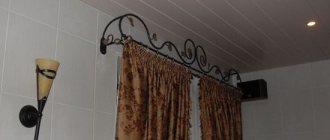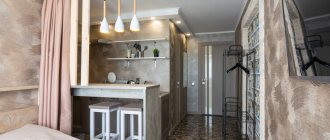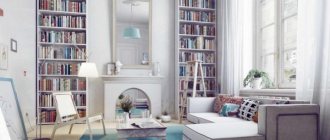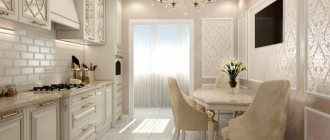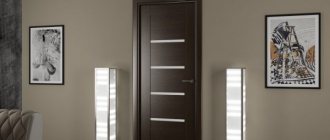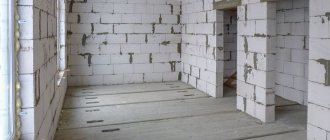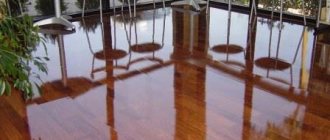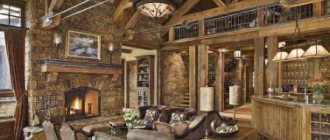Furniture and products made of artificial stone in the interior
Various stone products and furniture are currently quite popular and represent a brutal, but at the same time very sophisticated interior element.
Due to its discreet and sophisticated appearance, a stone sink can complement any design.
Plumbing
Monolithic sanitary ware, such as a bathtub or toilet, is distinguished by excellent tactile sensations during operation and gives the environment a special personality. A stone heated towel rail has increased heat transfer and evenly heats the surface.
The photo shows a toilet with a bidet made of decorative stone in the interior of the bathroom.
Tabletop
A kitchen countertop or base with a washbasin is distinguished not only by its interesting appearance, but also by its good technical qualities, allowing you to achieve excellent results when using it.
Bar counters
They will undoubtedly become an image item and an unusual interior element, which will make the atmosphere much more original and expressive.
The photo shows a kitchen interior with a bar counter made of liquid decorative stone.
Window sill made of decorative stone
It has a truly expensive, stylish look and is in no way inferior to a window sill made of natural material. A huge number of mineral coloring pigments and various additives provide a huge variation of shades and decor.
Accessories
There are a wide variety of accessories, such as table or floor vases, that look very aesthetically pleasing, have natural beauty and, even without additional filling, undoubtedly attract attention, creating interesting installations. Exclusive stone cutting boards always look presentable and fit perfectly into any kitchen space
Also, mirrors framed in the form of decorative stone look no less luxurious and elegant.
Shelves
They can become quite a bright interior detail that can be easily filled with books, figurines, boxes, vases, photo frames and thereby give the room more coziness and homeliness.
Bricks in the interior of the hallway: advice from professionals
If you are finally convinced of the idea of decorating the hallway wall with stone, listen to some advice from professionals.
Tips for decorating with faux bricks:
- On top of the finished decor, you can spray it a tone or two darker than the stone, so it will look more expressive;
- Use bronze or dark gold decor to highlight the contours of the masonry or highlight the highlights on individual bricks;
- If you apply a layer of acrylic varnish on top of a finished brick wall, the decor will last longer and look more shiny;
- Properly placed lighting will help highlight the beauty of artificial stone.
And most importantly, don’t be afraid to experiment!
Peculiarities
Artificial brick is a specially made decorative tile, the thickness of which does not exceed 2 centimeters. This makes it possible to renovate the apartment without losing space.
In addition, the range of colors, as well as the sizes of this material can be very diverse. In the interior, artificial brick is used to decorate walls in a variety of rooms. They can safely decorate a wall in the hallway, toilet, even in the bedroom. However, decorative brick is most often used in the hallway.
The disadvantages include surface roughness, as well as very low hygroscopicity. This leads to the fact that the material cannot be used in all areas.
Brick wallpaper: combination with other wallpapers
As a rule, all walls are not covered with brick wallpaper. In the interior it always looks very ridiculous. The central walls stand out with such wallpaper, but what to cover the rest with is an interesting question.
There are several options for combining wallpaper:
- Brick-like + plain in the color of brick
. A good option, especially for light wallpaper. The red brick wall and the other red walls are too much. - Brick look + stripe in the same color scheme
. Why not? This option is especially good in a small room with a low ceiling. - Under red brick + light olive
. The option is unexpected, but in many specialized magazines you can see examples of bedrooms with just such walls, and it looks quite cozy. - Under gray brick + white walls
. It would be nice if such a room had a lot of space and a lot of light. Place a gray sofa near a gray wall and decorate it with pillows that match the color of the other walls. - Under white brick + barely coffee walls
. Dance around such a pastel palette, without crowding the space with furniture; in a bright interior, everything unnecessary is very striking.
Well, in the kitchen, the central wall can be covered with brick, and the rest can be covered with calm wallpaper to match with a simple and unobtrusive gastronomic theme.
Coloring option
In bulk
It is considered the most practical and best way. In this case, coloring pigments in powder form, which are used for concrete, are added directly to the gypsum solution. Thus, you receive a product that is painted from the inside. When cutting or chipping, you will not see the white base.
A beige or yellow solution is best, and in polyurethane form, parts of the stones can be painted with liquid pigments using a brush.
For this:
- take ½ tsp. color (pigment);
- add 200 ml of water;
- add 200 ml of any acrylic primer.
When the stone has set, remove it from the mold and dry it, and after laying it on the surface, apply a matte water-based varnish to it.
This option for painting decorative gypsum stone is the most effective and almost all manufacturers use it. That’s why we can see these kinds of products in stores. The disadvantage of this method is the rough and unnatural painting, which can be observed at close range.
By making gypsum artificial stone yourself, you have the opportunity to work on naturalness by carefully painting parts of the stones in the mold. Of course, no one will do this on an industrial scale, otherwise the price will increase significantly.
Below we will propose another painting technology that will help make a product from gypsum tiles that is more similar to natural stone. You will learn how to paint artificial stone so that it has the same natural veining and color scheme as natural stone.
Surface
Prepare:
- water-based (coloring pigment);
- water;
- spray or brush.
The instructions are simple - you need:
- add a coloring pigment to the water, you can even add several at once;
- dip a brush into the solution;
- saturate gypsum tiles with it.
Artificial gypsum stone has unique properties of developing shades that are similar to natural ones due to the absorption of tinted water.
In order to give gypsum stone the desired shade and color, you do not need to have an artistic education. Dip the brush into the colored water and paint the stone as you see fit.
Then you can tint some with a dark solution consisting of color pigment and water. You shouldn’t think too much about the palette, since each gypsum tile, even with the same texture, will absorb the solution differently, which will allow you to create an individual pattern each time.
You can also use any sprayers for work, for example:
- spray gun;
- sprayer for glass cleaning products.
Pour paint diluted with water-based tinting paste into a container and spray it onto the gypsum tiles. It is better to use several of these sprayers with different colors in your work so that you can treat different places on the stone. Then the painting process will be better and faster.
The advantage of painting yourself
- The store offers artificial stone in standard colors and with obvious artificial coloring. It does not have natural colored veins, like natural ones.
- You can purchase products in white or plain beige, glue them to the walls, and then paint them on the spot with water and coloring pigments diluted in it. This method makes masonry much more natural. (See also article.)
- Once the plaster stone has dried and become faded and pale in appearance, open it with any silky matte or matte varnish. This way you can restore the color saturation of the product, strengthen and protect its surface.
- If you want to achieve a “wet” effect on artificial stone, use varnishes, but be aware that this will slightly reduce the naturalness of the material.
About the main advantages of using brick wallpaper
Repairing a corridor with such wallpaper has its own distinctive advantages:
Brick-like wallpaper in the corridor, photos of ready-made solutions can be found on design websites, are appropriate no matter how complex the design of the corridor is. Manufacturers of brick wallpaper have taken care to use high-quality materials and dyes, so after completion of the renovation work in the corridor it will not only be cozy and beautiful, but you will not have any difficulties in caring for such wallpaper.
In France, too, we find wallpaper implicitly associated with a rejection of history and tradition: Madame de Genlis bemoaned the frivolous, ephemeral form for English wallpaper, which had displaced tapestries from tapestry. Wallpaper itself stands for the decline of values, both moral and social. In the old days, when people built, they built over two or three hundred years, the house was furnished with tapestries that lasted as long as the building, the trees they planted were their childhood heritage, they were sacred forests. were cut down, and the children were left with debts, paper on the walls and new houses that were falling apart!
Finishing
When decorating a hallway with decorative bricks, you need to determine the area of the surface to be decorated. Then, having calculated the required amount of material and adding to it an additional 10-15% of the required amount, purchase raw materials. The reserve takes into account the loss of material during the fitting process, cutting or in case of accidental damage. In order not to take extra bricks, you can outline the boundaries of the masonry and prepare a diagram for the arrangement of fragments (especially important for bricks of different shapes and sizes). To simplify the task, the placement can be done on the floor, not forgetting to take into account the topography of the wall and the distance between the seams (the method allows you to adjust the laying order if the fragments do not match).
Having decided on the quantity, they prepare the wall, which involves the process of removing old paint, wallpaper and leveling the surface. For reliable fixation, use a deep penetration primer. You need to start installing the bricks from the corner: this eliminates the need to adjust the elements at the junction of the walls, which is problematic to do. When working, you should use a special glue for the specific coating chosen. The masonry is carried out from the bottom up in rows using the following technology: the joining seams between the bricks of the first row are placed in the center of the bricks of the next row. When laying materials that include shale and sandstone, seamless technology is used.
After the glue has dried, you need to wipe the surface with a damp, but not wet, cloth (this makes it easier to remove dust and other contaminants). It usually takes several days for the solution to dry completely. If antifungal treatment was not applied during the production of bricks, it is necessary to independently cover the laid surface with a special solution. This is a water-based varnish composition that protects the surface from contamination and accidental mechanical influences. It is applied after drying, gives the wall a glossy shine and visually expands the space.
As a budget finishing option, you can cladding one wall, on the surface of which it is better to highlight an arch, mirror or niche. You won’t need many bricks for such a renovation, and the decoration effect will pleasantly surprise you. For better design, you should purchase lightweight, wear-resistant materials. When choosing the main tone of the walls, you should not choose too dark shades, because often there is no natural light in the corridors. Considering the purpose and specifics of the corridors, it is preferable to use easily washable materials.
After completion of the work, it is recommended to cover the surface with spraying, the color of which will be a couple of tones darker than the shade of the artificial stone. This will make the surface more expressive. An interesting technique would be to highlight the outline of the masonry with bronze or dark gold paint. An additional coating of acrylic varnish will help make the brickwork glossy, and well-placed lighting will emphasize the aesthetics of artificial stones and make the corridor stylish and solid.
The principle of decorative wall decoration
Regardless of what kind of brick will be used in the interior of the hallway, clinker or finishing, it should be taken into account that this type of material fits quite difficult into the space of the room. At the same time, this decorative material can perfectly fit into any style solution and make the interior unique. Installation is based on the following technology:
- Level the surface of the walls in the hallway for attaching the finishing material, which will ensure the quality of installation.
- Prepare a special tool or grinder for cutting the material if necessary.
- Purchase a special adhesive solution that allows you to strengthen the facing or decorative brick in the interior of the hallway.
- Lay the finishing material, starting from the corner, according to the principle of brickwork, placing the seams of each row in the middle of the bricks of the adjacent row.
- Remove excess mortar after it has set.
- After the solution has completely hardened (5 days), clean the finishing coating from dirt using a regular damp cloth.
- If the material does not have a special protective coating, a special antifungal solution is used to protect the masonry from fungus.
- Use a special water-based varnish to coat the finished surface to protect it from damage and contamination.
If all actions are carried out correctly, the decoration of the walls in the hallway should be not only beautiful, but also practical.
To create a higher-quality wall decoration, you should select those types of materials that are easy to clean, wear-resistant and not easily soiled.
The walls of the room should not be too dark in color, since hallways often do not have sufficient natural light. It is best to select materials that can be wet cleaned at any time. The use of delicate materials is unacceptable, since they will wear out when touched by bags or shoulders.
In general, the process of decorating a hallway using decorative stone is quite simple. To perform the work efficiently, certain knowledge and skills will be required. The correct selection of material will allow you to fit the brick into the interior of the hallway to the maximum extent.
- Material characteristics
- Laying decorative stone Complex elements
Decorative stone is an excellent modern building material used today for interior and exterior decorative finishing of walls and floors. It is much easier to lay it yourself than ceramic tiles, so you can handle the work yourself and at the same time save a lot. Moreover, such finishing with your own hands does not require special construction tools and materials.
It is better to carry out the work on a prepared surface, which means that the surface must first be leveled. Due to the peculiarity of the material from which the decorative stone is made, there is no need to set the plane to zero when working with it. In this case, you don’t even have to observe the rows, although even rows will significantly improve the appearance of the finished product. In their work, some craftsmen do not level the walls, but simply make a “Christmas tree” from glue. This can significantly improve the coupling while saving material consumption. If you plan to lay out the stone material in even rows with your own hands, first of all you should lay the first row strictly level.
Scheme of facing a corner with decorative stone: a - wood, b - waterproofing, c - reinforcing mesh, d - cement glue, e - artificial stone.
You can attach the stone to the walls using regular tile adhesive or a special solution for stone. Choosing a decorative stone is not difficult. Today the market is ready to offer a wide selection of different shapes, structures and patterns. Decorating walls with decorative stone can be done everywhere, since it can easily be combined with any other finishing material, be it wallpaper, ceramic tiles or decorative plaster. The stone does not like haste in laying, the rows can float. Decorative stone can be laid both indoors and outside the house. However, it must be attached to walls outdoors using only special glue.
Among the advantages that artificial decorative stone has are:
- environmental friendliness of natural;
- durability;
- ease of installation;
- good fastening to the wall;
- wide selection of textures and shades;
- There are special shaped elements for finishing corners.
Room design
To make the design of any interior look beautiful and aesthetically pleasing, you need to choose the right areas and shades of the product. You should purchase something that will be in harmony with the palette of design and furniture.
Living room
It is necessary to pay extreme attention to the design of this room, since it is where various special events, family gatherings and meetings of friends are most often held. Modern interiors allow you to use an accent in the form of a brick wall, making the room more cozy and atmospheric. Masonry is a wonderful decorative element, so it is not necessary to decorate it in any way. If you still want to add something, you can place some beautiful photographs or posters on the masonry. They will look harmonious and will not clutter the room.
For the living room you can choose any shade of the product
It is important that it is successfully combined with the design. Some decorate one wall, while others decorate separate areas.
Both options look decent. A fireplace or stove made of brick looks incredibly attractive and interesting, as well as a niche located in the wall, which will create a special, pleasant and cozy environment. An ideal option for a living room combined with a kitchen is a medium-sized brick wall, which will help separate the zones.
Bedroom
Brick elements in the design look extremely warm, so quite often this element is used when decorating a bedroom. Brick combines well with a variety of facing materials. It is often used to decorate the wall at the head of beds or the one on which the TV panel is located. If the room is too narrow, and the back of the bed is located against a long wall, it is this surface that is decorated with interior brick. This allows you to make the room wider, as the wall moves away visually.
Hallway
If the corridor is small, decorating with light decorative material, the surface of which is glossy, is suitable. This option allows you to make the room larger and more spacious. Most often, this solution is used for Scandinavian style or minimalism. You can make a fragmentary finish with red brick, decorating the corners, areas at the joints of surfaces, arch areas and the entrance door opening. If the room is large, masonry can help with zoning.
Kitchen
Even if the room is extremely large, you should not use too much brick in its design, as this can ruin the interior. It is better to make brickwork a connecting link between different types of finishes. It is worth correctly determining the wall on which the material will be placed: the masonry should be on the surface on which natural light falls. If you want to use red brick, it is better to use sources of additional lighting, since such elements will absorb light.
Bathroom and toilet
The microclimate in the bathroom and toilet is specific, so interior brick is not a very good option for these rooms. If it is still used, the elements should be treated with a special agent that will rid the apartment owner of mold. It is also better to use an antibacterial composition. The rough surface of the brickwork and snow-white plumbing is a combination that looks extremely attractive. In most cases, surfaces are decorated using plastic panels or tiles that imitate brick.
Balcony
Decorating a loggia with decorative bricks is a good idea, because it looks harmonious and beautiful. If the balcony is small, you should choose thinner elements. With this decoration you can create a cozy and pleasant room for rest and relaxation. Both light and dark bricks are used. If desired, you can decorate the area around the doorway with gray or aged brick. Both options look very interesting and modern.
How to get the effect of exposed masonry
There are several options for decorating a brick wall. It can be found in the original. Brick houses and old factory workshops rebuilt for housing are rich in such luxury. In other cases, you will have to do it yourself, using available materials and relying on the general concept of finishing. The following will help bring a street accent to the hallway:
- clinker tiles;
- brick veneer;
- textured vinyl and paper wallpaper;
- transparent glass brick;
- plastic panels.
The easiest way to get the desired decor is to lay out the masonry yourself or separate it from the finished wall surface. If you move into a new building, then leave one of the walls unfinished. Remove construction dust from the selected area and the decorative element is ready!
In an older building, it will be more difficult to expose the brickwork. Here you will have to remove all the layers of plaster and finishing materials that have been applied over the years, and then get rid of construction dust, remnants of the bonding mortar and wash off all the stains left by them with a special composition. Then the surface will need to be sanded and the exposed seams thoroughly rubbed. Look at the photo to see how natural brickwork in a hallway can look.
Trick 1. The selected decorative area will get a more attractive look if it is coated with colorless varnish.
Trick 2. Use matte varnishes. Bricks treated with them will not appear “wet”.
To decorate a natural brick wall in the hallway, you can use a monochrome retro photo or a picture with a suitable theme, placed in a wide baguette frame.
Peculiarities
Not every apartment can accommodate an additional brick row - buildings these days are built from metal and concrete, wood and frame structures have become the norm. Not every structure can withstand heavy brickwork. But you shouldn’t give up such a spectacular design option. An alternative could be gypsum tiles designed to look like brick.
It, like any other material, has certain pros and cons, knowledge of which will help you make the right choice.
Advantages:
- Safety. Gypsum is a material of natural origin, therefore, products based on it are environmentally friendly.
- Durability. Compared to many other finishing options, it has greater strength that is maintained throughout its service life. Often used in places most susceptible to abrasion and mechanical stress.
- Thermal insulation. Due to its low thermal conductivity, it retains heat inside the room, preventing the cold from penetrating outside. A wall covered with such material will never freeze.
- Noise insulation. The density of the material is high, sound permeability is low, and accordingly, noise penetration is minimized.
- Fire resistance. Withstands direct flame combustion temperatures and can be used for direct lining of stoves and fireplaces. When heated, it does not emit any hazardous substances.
- Maintaining a comfortable indoor microclimate. Absorbs excess moisture from the air, releases it in case of excessive dryness, and evens out the temperature of the surrounding space.
- The ability to create a realistic texture, place accents, and emphasize the dynamism of the interior.
- Weight. Gluing can be carried out on any wall without reinforcement using almost any adhesive, and does not carry a global load on the floors.
- Ease of installation and processing. You can start work with absolutely no experience.
- There is no need to purchase additional equipment or special materials.
- Price. The price/quality ratio is ideal. The price of the material is low, moreover, it is possible to manufacture it yourself.
Flaws:
- More suitable for interior than exterior work.
- Excessive hygroscopicity is a contraindication to placing the material in street decoration; however, today the production of gypsum-cement boards has been launched, which is quite suitable for exterior finishing.
- Increased fragility. This indicator can be reduced by adding special substances at the manufacturing stage and treating the surface with them after installation.
- Difficulty in care. An untreated gypsum surface can accumulate dust.
- When tiles are placed in a room exposed to high humidity, they must be treated with additional protective and water-repellent solutions.
Types of decorative finishing stone
Today there are three types of decorative artificial stone used for interior decoration:
- cement-based;
- gypsum based;
- agglomerate.
These products are very similar in appearance to natural stone, only they weigh much less (from 14 kg/m² to 50 kg/m²). The cost is also much lower (compared to natural), especially if the manufacturer is Russian or Belarusian. The advantages include easier installation - only the front part is textured, the other three are more reminiscent of tiles or bricks.
Actually, there is another type of artificial finishing stone - clinker tiles, imitating brickwork of various types. It is made from clay using almost brick technology - fired in a kiln and glazed. The difference in thickness is 1-3 cm. This type of finishing is good in many modern interiors - from high-tech to loft.
Samples of clinker tiles to imitate brickwork
Gypsum based
Gypsum finishing stone is the most inexpensive of this type of materials. Its second advantage is that it is the lightest. This is what is used when installing on drywall, since it simply cannot withstand heavy loads. Disadvantages - it is quite fragile, hygroscopic, and can collapse if wet. Decorating a hallway with decorative stone based on gypsum is possible only if, after installation, it is treated with a special protective impregnation or acrylic-based varnish.
The format of gypsum tiles can be any - a very plastic solution allows you to get any surface and shape
Light shades in hallways do not “pressure” and do not add heaviness
Heterogeneous color adds extra volume and charm
Gypsum decorative stone in combination with a gypsum panel in the corridor - oriental style
Decorative stone stands out especially against the background of smooth walls
Different color options of one collection
Cement based
A strong and durable finishing stone is obtained from a gypsum-sand mixture. It can be washed, even with a brush and liquid detergent. Its disadvantages:
- Hard to cut. You will need a grinder with a diamond blade to reduce dust, you can wet the tiles.
- Heavy weight. This is when compared with a gypsum analogue, and compared to natural, the weight is more than half as low.
- Higher price. In the production of cement decorative stone, high-quality cement is used, and it costs a decent amount. In addition, the production technology affects the price - cement takes longer to gain the required strength (28 days), and until this moment the molded tiles must be stored somewhere, and under certain conditions (at a temperature of about 20°C and sufficient humidity of 40-50%). This means that significant areas for storage space are required, and this means additional costs.
All these shortcomings are compensated by durability and ease of maintenance, so this is one of the most common decorative stones for interior and exterior decoration.
Combination of decorative stone and wallpaper in the corridor
This type of decoration in the hallway is convenient in terms of cleaning
You can completely line the walls in the hallway with decorative cobblestones
Interesting color
Light gray is just right for a small hallway
If you decide to make such walls, the lighting should be bright
An excellent option for decorating a fashionable loft style
Artificial agglomerate stone
This type of decorative finishing stone has appeared recently. It consists of natural rocks crushed to crumbs - marble, granite, quartzite - to which polymer resins or cement are added. To obtain bright colors, a coloring pigment is added. This decorative stone looks great - interspersed with natural fragments, reflections on the edges of the crumbs... It looks really good, suitable for finishing work indoors.
Granite agglomerate
Samples on the stand of one of the class=”aligncenter” width=”600″ height=”437″[/img]There can be many color options: quartz agglomerate
Painting methods
When choosing a collection made from gypsum or cement, pay attention to the method of painting. Pigment can be added to the solution, and then the entire tile will be the same color
Tints are then applied to its front surface, which give the surface a more natural look. With this technology, even when chipped, the difference will be unnoticeable, since the shades are close.
In another embodiment, the pigment is applied only to the surface. Then, if it is chipped or needs to be cut, the color will be very different.
Finishing of decorative cladding
First step. Mix red and light ocher.
Second step. Add a little white to the mixture.
Third step. Treat decorative masonry using the tampon method. To do this, take a sponge, dip it into the thick mixture prepared in the previous stages, and evenly distribute the composition over the cladding.
Fourth step. Take liquid paint of a brown shade or close to it. Spray the paint onto the trim using a toothbrush.
To achieve a more effective and natural finish, you can use different painting techniques for each row. For example, you can treat the second row of masonry with cold hematite diluted with water, cover the third row with a mixture of sienna and white, etc. Apply all coloring compounds using the same tamping technique. Alternate shades in order.
Finally, coat the imitation brick wall with a couple of coats of varnish. If you want to give the cladding a matte surface, carefully sand it with fine-grain sandpaper.
To create an imitation brick wall yourself, you don’t need to be a great master. Choose the method you like best and start finishing according to the instructions.
Good luck!
Video - DIY brick wall imitation
Decoration of premises is done in many ways. If we consider the cheapest and most accessible technologies for independent implementation, then one of the simplest and cheapest is imitation brickwork.
This design option is applicable to almost any building, regardless of the wall material. How to do this with your own hands, without the involvement of assistants, and especially specialists, we will figure out in this article.
Decorative brick in the living room interior
Let's answer two important questions first. Does brick always look good in a living room? Of course not! Can faux brick be used in living room decoration? Of course yes!
However, you yourself understand this perfectly well. It was said earlier that the bedroom should be cozy. Sure, but the living room should be more than just cozy. It should be the center of comfort in your home.
After all, the living room is where you spend most of your time in the house. A place where you relax, where you meet friends.
Speaking of a living room that has a brick wall, we can say that this wall becomes the center of your home. The wall that you get should not deny the entire decor of the house and contrast itself with all other design elements.
Maximalism in design is not for everyone. Before using brick in the interior of the living room as in the photo, think three times about the need for such a decision
When planning to use such material, always remember that in an apartment or house there is a room that is the center of your home. Therefore, it should be organized in the same style as the rest of the house. All rooms in your home should create a single whole with this center.
Well-designed brick living room interior. The almost pastel colors of the masonry are in perfect harmony with the overall color scheme of the entire furnishings and its details.
Brick tiles in the living room can make an accent wall, and spotlights will add an atmosphere of mystery and mystery
Real brick from the old masters can also be an excellent solution for adding style to the living room
Is it worth decorating such a wall in the living room?
In itself, such a design element is already an attractive element, but minor additions can positively enhance the effect. But under no circumstances should you overdo it with the amount of additional decor. Extra redundant photos, pictures - all this will lead to the opposite effect.
Attach two or three family photos from a long trip or an interesting painting to this wall. Also, if possible, install a fireplace near the wall. It's a really good idea to have a simple electric fireplace and a few directional spotlights. Family comfort and an atmosphere of calm and tranquility are guaranteed to you.
This is no longer just a few rows of laid tiles. This brick living room with a fireplace really takes us back to the old days and creates a feeling of comfort and warmth.
Natural, familiar colors are a frequent choice of designers
Brick decor in different rooms
Hallway
Brickwork in the interior of the hallway is very popular. Here it is better to choose dark colors, on which dirt will be less noticeable. An antique type of tile with scuffs and cracks will cope well with this. Sometimes you can line all the walls of the hallway with brick and it won’t seem like an excess. But in most cases, it is appropriate to finish one wall, highlight an arch, a niche for a mirror or another element (examples in the photo below).
In the design of a small hallway, brick decor is often inappropriate. The tiles hide too much space, and their dark tones make the room visually cramped and gloomy. It is most appropriate to use white brick in the interior of a small hallway. Light textured wallpaper as in the next photo will also work.
Living room
The possibilities for using decorative bricks for the living room interior are very wide. Modern design styles often offer the technique of highlighting one wall. It becomes the main “highlight” of the room, and it is on it that the main decor is placed, along with the main recreation area (photo).
When choosing decorative bricks for your living room interior, pay attention to the color.
In a large room with high ceilings, aged red will be most appropriate, and for small rooms it is better to use white (you can replace brick tiles with wallpaper).
Brick decor is a good way to designate a fireplace area in the living room. It is possible to decorate the fireplace itself or the elements framing it, the podium, or parts of the walls with brick. To make the atmosphere of the living room even more cozy, it is good to use fresh flowers and country-style textiles in this seating area. You will be able to achieve maximum harmony if you choose the antique look of brick tiles.
White brick looks stylish and modern in the interior. The design of the living room will be especially harmonious if you complement the wall with minimalist furniture and laconic decor, as in the photo.
Kitchen
The use of bricks can also be very diverse. A common option for designating a dining area. In this case, the entire wall in the kitchen or part of it is finished. If the dining table is on a podium or separated by an arch, then these architectural elements can be additionally highlighted with brick for the interior.
The technique of finishing a kitchen apron with brick tiles is often used. This allows you to add color to a modern kitchen design and create an interesting contrast with modern appliances. Tiles made to look like antique masonry will look especially original. Small bricks placed on the apron look good in the kitchen interior.
An almost win-win option would be fresh flowers in the kitchen. When paired with them, brick tiles work equally well with any design style.
If you are renovating your apartment with your own hands and decide to choose wallpaper with a brick texture, then pay attention to those that can easily withstand wet cleaning (this rule also applies to the hallway).
Bedroom
The most common way to use decorative brick for a bedroom interior is as an accent wall. There may be different options here - antique masonry, white or red brick, textured wallpaper (they will be the best choice when the renovation is done by yourself).
The photo below shows how cozy it becomes in such a room. Brutal brick tiles in wall decoration emphasize the warmth and softness of pillows and textiles. Depending on the chosen design style, the overall picture will be well complemented by flowers, large laconic paintings, voluminous curtains or a canopy.
Decorating apartment walls and individual elements with brick is a very popular topic today. If you do everything yourself, then decorative tiles will help you combine different textures for interesting results. However, it is important to understand the installation technology, otherwise it’s easy to ruin everything. When in doubt, it's best to choose high-quality textured wallpaper. Among them there are durable, moisture-resistant types that will be an excellent wall decoration even in the kitchen and hallway.

